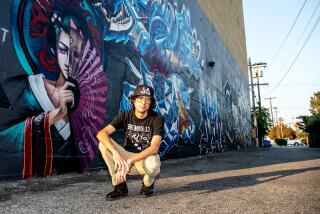A newspaper unplugged in Japan’s quake zone
Reporting from Ishinomaki, Japan — Moments after the massive earthquake struck this northeastern Japan town, editor Hiroyuki Takeuchi gazed about his tiny newsroom and took stock: His computers were worthless; his printing press on the floor below would soon be flooded by the tsunami.
Still, the next day Takeuchi and his staff of six reporters made sure the Ishinomaki Hibi Shimbun hit the streets just as it had for the last 100 years. For six days, working by flashlight, wearing overcoats in the chilly office, they put the paper out by hand, with black felt-tip markers and large sheets of white paper.
The afternoon paper’s daily circulation fell from 14,000 to just six hand-copied issues, which the staff posted at community centers and convenience stores — anywhere residents congregated.
The day after the disaster, the paper’s top headline read, “Largest Quake to Hit Japan; Massive Tsunami,” and later declared “total destruction” in nearby cities. Soon, reporters found people waiting for the daily posts.
For city editor Takeuchi, who’s spent his entire three-decade career at the paper, such success underscores one of his key beliefs: It’s not a newspaper’s size, but its passion, that counts.
“In Japan, people are not accustomed to questioning the government or big companies, so the newspaper becomes their voice,” he said.
Speaking in a near-whisper, Takeuchi leaned forward and made a confession: His father thought he was too passive to be a good journalist.
But the taxi driver’s son had other ideas. He’d read about the exploits of Bob Woodward and Carl Bernstein, two American reporters who brought down a president, and wanted to bring the same willful verve to Japanese journalism — in his own quiet way.
At 22, Takeuchi joined the Ishinomaki Hibi Shimbun as a cub reporter. Since then, he has worked every position at the paper, following a simple credo: To better serve readers, journalists must get out on the street and ask hard questions, not just sit in the office and rewrite press releases.
“Reporters,” the 53-year-old said, “must move their feet.”
When he first started in the small, second-floor newsroom, he worked the police beat and soon noticed a disturbing trend: Without their own fully equipped hospital, residents were forced to take an ambulance to the nearest city, an hour away. Takeuchi spent a week with an ambulance crew for a story about a woman rendered brain dead because doctors did not treat her in time. The piece persuaded local government officials to build a top-notch medical facility.
On March 11, the paper once again provided a public safety net. At 2:46 p.m., just after the day’s edition had gone to print, Takeuchi’s newsroom began to violently shake. Within minutes, he dispatched staffers into the community. One reporter was washed away with his car, but survived. Takeuchi didn’t hear from another for more than a week.
He surveyed his workplace. The paper had been ushered back into the journalistic Stone Age. “Right away,” he recalled, “we knew we were in trouble.”
He huddled with the newspaper’s publisher, Koichi Omi, and talked about how after World War II, the paper’s reporters had secretly written stories by hand to bypass government censorship. “Readers needed us,” Omi said, “so we decided to publish with our own hands.”
The paper soon forged a disaster routine. Three staffers were assigned to evacuation centers. Before noon, another ventured on foot to collect their handwritten dispatches.
Yokoi Yasuhiko, 33, waded into murky floodwaters that reached his neck. “I couldn’t see my feet. I didn’t know where to step,” he recalled. “All I could think about was that I didn’t want to allow those notes to get wet. So I held them high over my head. And I went very slowly.”
Back at the office, Takeuchi compiled the reporter notes and dictated the day’s stories as Omi hand-printed the first of six copies on sheets of poster-sized paper. “I had the best handwriting,” he said. The rest were done by other staffers.
In the end, their voice was heard within their own community and across the world — even in the U.S. city where Takeuchi’s heroes Woodward and Bernstein made their own journalistic mark.
The Newseum journalism museum in Washington acquired six original quake-era copies of the paper for its permanent collection, likening the accomplishment to such historic publishing feats as when a newsprint-deprived Civil War-era newspaper in Vicksburg, Miss., printed on wallpaper.
“Without the benefit of any of the 21st century conveniences or technological advancements, and in the face of significant personal hardships, these journalists were distinctly committed to providing their community with critical information, and they used simple pen and paper to do it,” wrote Carrie Christofferson, curator of Newseum collections.
Back to normal press runs, the staff isn’t resting on its laurels: Thousands of residents have been confirmed dead, including many of the newspaper’s readers.
Takeuchi is baffled by the accolades, saying, “I thought this is what newspapers are supposed to do.”
More to Read
Sign up for Essential California
The most important California stories and recommendations in your inbox every morning.
You may occasionally receive promotional content from the Los Angeles Times.











